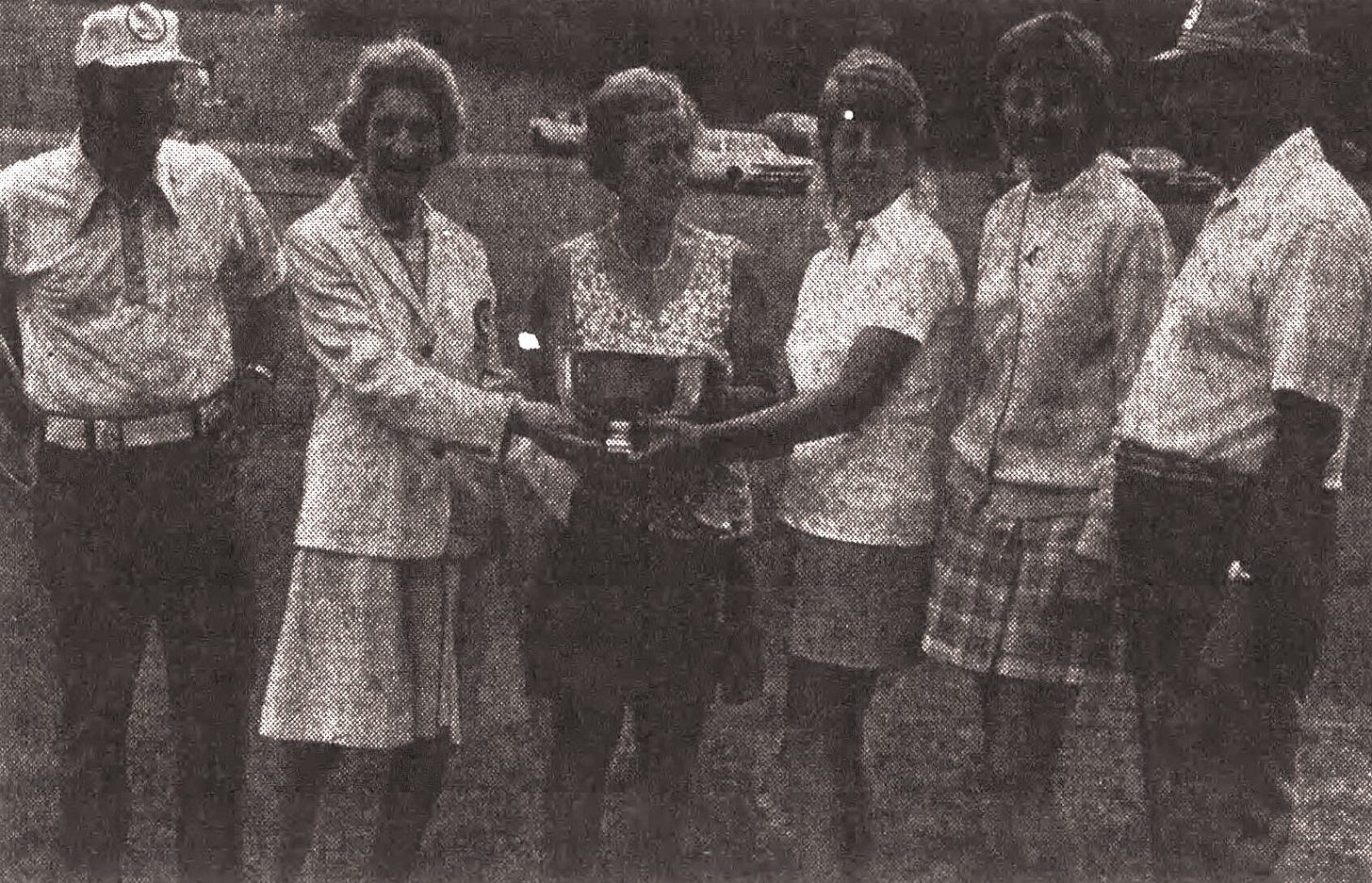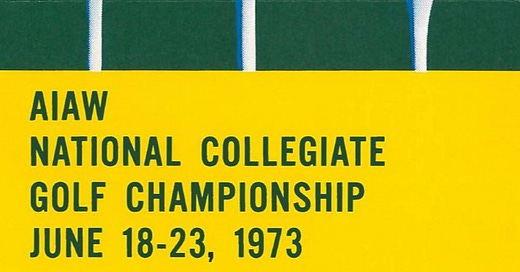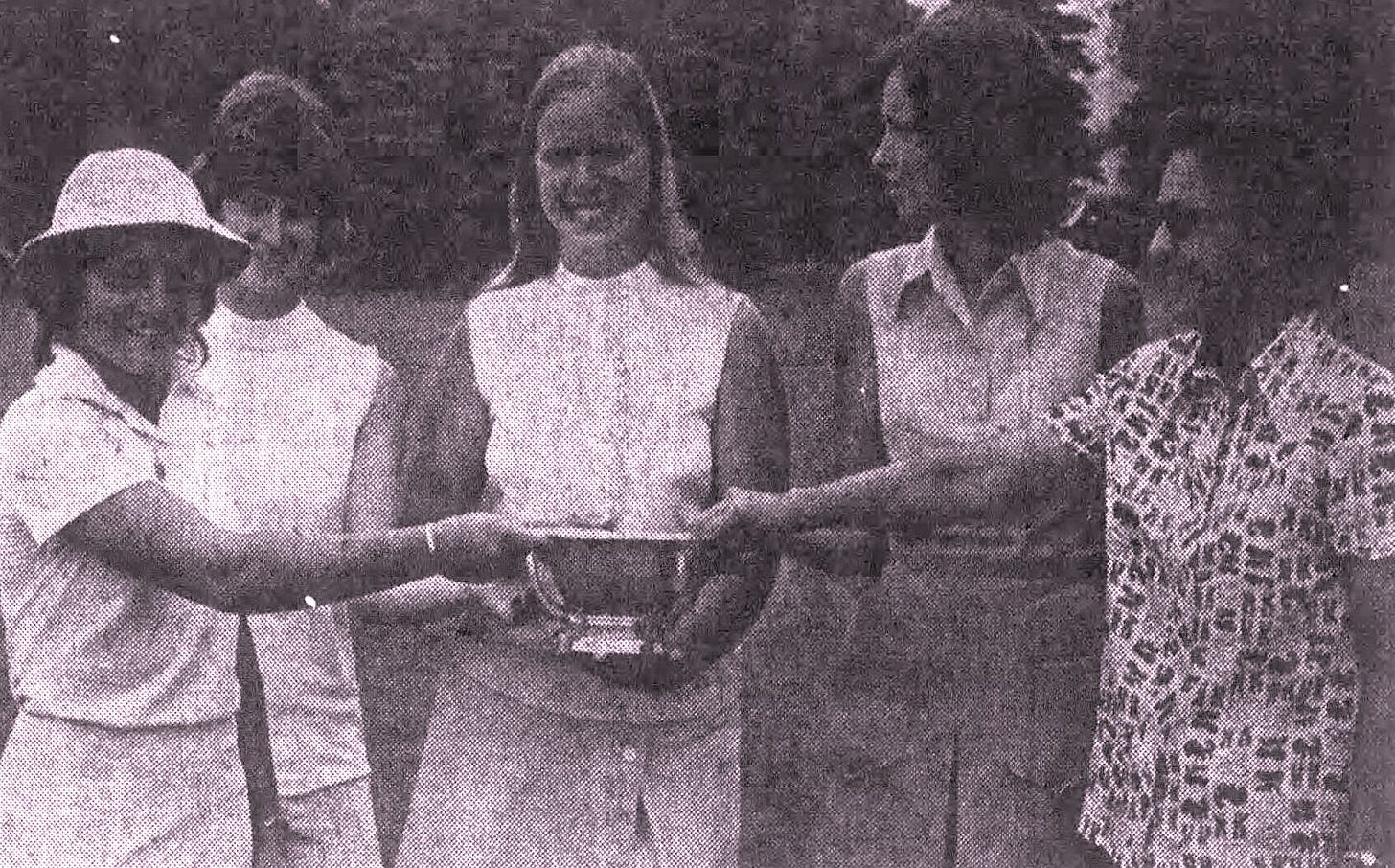This is part of a series on the Women’s Collegiate Championships
Over 30 years after the Ohio State Physical Education staff made their initial push for a “Women’s NCAA”, the AIAW was created to fulfill that very role in leading women’s collegiate sports into the realm of fully organized competitive athletics. As this new organization was being formalized, the Women’s Collegiate Golf Tournament underwent a pretty radical format change with the move to a strictly stroke play 72-hole event to decide both the team and individual champion. The 1973 edition of the tournament was the third to feature this new format but the first run under the guidance of the AIAW. Brewing in the backdrop of this tournament was a seemingly pleasant summer shower in the form of a new set of federal regulations known as Title IX that might even bring a flood of new money to all women’s sports, however there was just a hint of distant thunder booming from the NCAA.
*NOTE 1: underlined text provides a link to references or sites with more information
*NOTE 2: we have done our best to cull out sources that contain problematic language or sentiments, but sometimes those things cannot be helped or are otherwise included to illustrate a point; we hope you understand this usage and recognize its educational purpose is not an endorsement
THE AIAW
CREATION
In November 1970, representatives for the various groups organized under the American Alliance for Health, Physical Education, and Recreation (AAHPER) met to discuss taking the final step in actualizing the “Women’s NCAA” that Ohio State had proposed and tried to start way back in 1940. Although the CIAW had only been in operation for a few years, it had been deemed successful in not only operating the national championships - six including the golf tournament - but also effectively creating the structure to support as many collegiate sports and championships as would/could be played. The problem was that the organization lacked true membership and any real teeth beyond the carefully named “guidelines” it had implemented. Most of the groundwork was hashed out in that November meeting so that the following April (1971) an official proposal was put in front of the Division for Girls and Women’s Sports (DGWS) Executive Committee - the parent organization for the CIAW - to create the National Association for Intercollegiate Athletics for Women (NAIAW). The DGWS approved the proposal with some minor changes, including dropping “National” from the name, and it was put in front of the AAHPER Board. In late 1971, the dues-paying membership organization for women’s athletics known as the AIAW was approved and set to begin operation in July, 1972. Based on that late date, the first AIAW National Intercollegiate Golf Championship would officially be held in June, 1973.

TITLE IX (June 23, 1972)
Another major change around that same time was the passage of Title IX of the Education Amendments of 1972 which was enacted by Congress and signed into law by President Nixon that June. As summarized by the Women’s Sports Foundation, this “prohibit[ed] sex discrimination in any education program or activity receiving any type of federal financial aid.”. Later updates and provisions would be passed in the coming years result in even more changes with respect to women’s sports - and will be covered in future posts - but this provided the firm foundation for a major turning point in the collegiate athletics throughout the United States.
FORMAT CHANGE
With a few minor exceptions, the format for the Women’s Collegiate Golf Tournament had remained largely unchanged for the first 26 playings of the event. That changed in 1971 when the event moved to stroke play only, forgoing the match play element for the individual title. Furthermore, more rounds were added, meaning both the individual and team titles were determined through four rounds (72 holes) of stroke play.
1971 Championship [hosted by Georgia]

Not only was Georgia’s hosting of the 1971 championship monumental for the geographic location of the venue, but also for the major shift in format. Stanford’s Shelley Hamlin won by four strokes with rounds of 74-74-77-76=301. Her 4 stroke victory was made especially sweet by defeating fellow Fresno, CA native and “cross town rival” Janet Webber. Webber, however, also left with championship hardware as she and her UCLA Bruin teammate Carol Grinder ran away with the team title (620) over last year’s champions, Arizona State (638).
1972 Championship [hosted by New Mexico St]

Ann Laughlin [Miami (FL)] followed in the footsteps of fellow Hurricane standout Roberta Albers (Speer) in winning the women’s golf championship in her freshman year. While Roberta won hers through match play after 18 holes of stroke play qualification, Ann’s title was determined through four rounds of stroke play in which her 30-footer on the final hole secured both the individual trophy for herself and the team title (their second in three years) for the Hurricanes. Ann Laughlin (Fulginiti) was inducted into the university’s sports Hall of Fame in 1987 and “…will be remembered as one of the greatest golfers in UM history.”
THE TOURNAMENT [June 20-23, 1973]
The AIAW era began for college golf in a rather unexpected location, hosted for the first time by Mount Holyoke College. Ruth Elvedt, who was both the Director of Physical Education at Mt Holyoke and the AIAW Program Director, was apparently instrumental in bringing the tournament to the relatively small Massachusetts college. Despite the location, it was another 100+ participant turnout thanks in part to the concept of having membership schools, a new development brought with the creation of the AIAW. The men had experienced a similar boost when the NCAA took over running that championship in 1939.
INDIVIDUAL RESULTS
In the first round, Pat Bradley [Florida International] bettered par 74 by a stroke which also bettered the course record set all the way back in 1930 by the original course owner’s daughter, Elisabeth Skinner. What’s more incredible is that Pat actually beat the mark by three strokes (71), but after the round she was assessed a two stroke penalty for following the preferred lies option to lift-clean-place on the wrong hole.
The third round saw another 73, this time by one of the pre-tournament favorites, Hollis Stacy of Rollins College, who at this point was best known for her three consecutive US Girls Junior Am championships (1969-71). This vaulted her into a tie for second place with Candy Robertson [UNC-Greensboro] at 233. They stood just three strokes behind Michigan State’s Bonnie Lauer who was the only competitor to shoot in the 70s all three rounds.
Hollis Stacy closed the tournament with a strong final round 75, however Bonnie Lauer matched her to preserve the three stroke victory. With her win, Lauer joined Joyce Kazmierski (1966) as Spartans to take the individual title. Also like Kazmierski, Lauer was an early inductee into the Women’s Golf Coaches Association (WGCA) players Hall of Fame in 1987. A couple years after winning her title, Lauer turned pro in 1976 and did something Kazmierski wasn’t able to do: earning the LPGA Tour’s Rookie of the Year Award.

TEAM RESULTS
Over 30 teams brought more than one player which allowed them to qualify for the team championship, several even brought as many as four players. The championship scores were determined by the two best scores from a given team over the 72 holes, results:
631 - UNCG
632 - Rollins
648 - Arizona State
653 - Arizona, Michigan State
656 - Miami Dade JC
663 - Florida
675 - Furman
685 - Cornell, Ithaca College
687 - Alabama
688 - New Hampshire
695 - Western Kentucky
697 - Idaho
699 - Buffalo State
704 - Stanford
705 - Odessa JC, Cal St LA
708 - UCLA
710 - Southern Illinois
711 - Miami (FL) [reigning champs]
720 - San Diego State
728 - Longwood College, Ohio
736 - Stephens College
737 - Texas
740 - Illinois State
745 - Georgia
772 - Florida State
779 - Minnesota
796 - Mt Holyoke College [host]
813 - Springfield College
The 1973 UNCG team, which earned the school its first national championship, was inducted as a group into the university’s sports Hall of Fame in 2004.

THE PROBLEM OF SCHOLARSHIPS
We mentioned in an earlier post about the notion of golf scholarships being a not only limited but also a starkly negative thing that, in the eyes of the USGA, ran against the values of amateurism in the sport.
USGA Rule 1 (1960 rule book)
The following are among examples of acts at any age which violate the Definition of an Amateur Golfer and cause forfeiture of amateur status:
1-12 Proselyting and Athletic Scholarships
Because of golf skill or golf reputation, accepting any consideration as an inducement to be a student in an educational institution. However, a student may accept a scholarship granted and approved by the institution’s regular central authority awarding all scholarships.
JoAnne Gunderson is reportedly the first woman in the United States to receive a “golf” scholarship to attend Arizona State, however the distinction was made that she received a general scholarship rather than a sports-specific one so as not to run into trouble with amateurism. By the late 1960s, the USGA had removed much of that “Proselyting” language from their rulebook, but the sentiment still remained for men’s and women’s golf at large, just as the DGWS and then AIAW began to bolster national women’s sports competitions.
Unlike the NCAA, where the limitation on golf was one of the exceptions, the AIAW had a general policy against athletic scholarships that was adopted from the DGWS. In fact, as the AIAW was coming into creation, the Collegiate Golf Committee specifically mentioned the “scholarship problem” in the documents sent to tournament officials ahead of the 1971 championship (see below).

Just two years later, in April 1973, the AIAW issued a national press release indicating that they had reversed the ban on athletic scholarships. Why? Because of a lawsuit brought by Fern “Peachy” Kellmeyer, a former Marymount physical education director who had just become the first executive director at the newly created Women’s Tennis Association (WTA), that was dubbed Kellmeyer v. National Education Association. In her lawsuit, Kellmeyer questioned the legality of the AIAW’s anti-athletic scholarship policy, citing (among other things) Title IX. Although the AIAW wanted to refute and fight the lawsuit, its parent organizations (NEA and AAHPER) were not supportive of that action, and so the AIAW eventually relented. There is much more nuance to this subject and if you’d like to learn more we would highly recommend reading pieces such as this one published by Marquette Sports Law Review in which the author, Ellen J. Staurowsky, gives more historical context (starting on page 585) and makes an interesting argument over whether or not the AIAW scholarship ban was actually a case of discrimination based on sex.
Thanks for reading!
Up Next:
In the next post for this series, we will cover Nancy Lopez’s (and Tulsa’s) rise to stardom with the 1976 championship and Colgate’s entry into women’s college golf with a donated trophy, as well as the scholarship that links them together.







